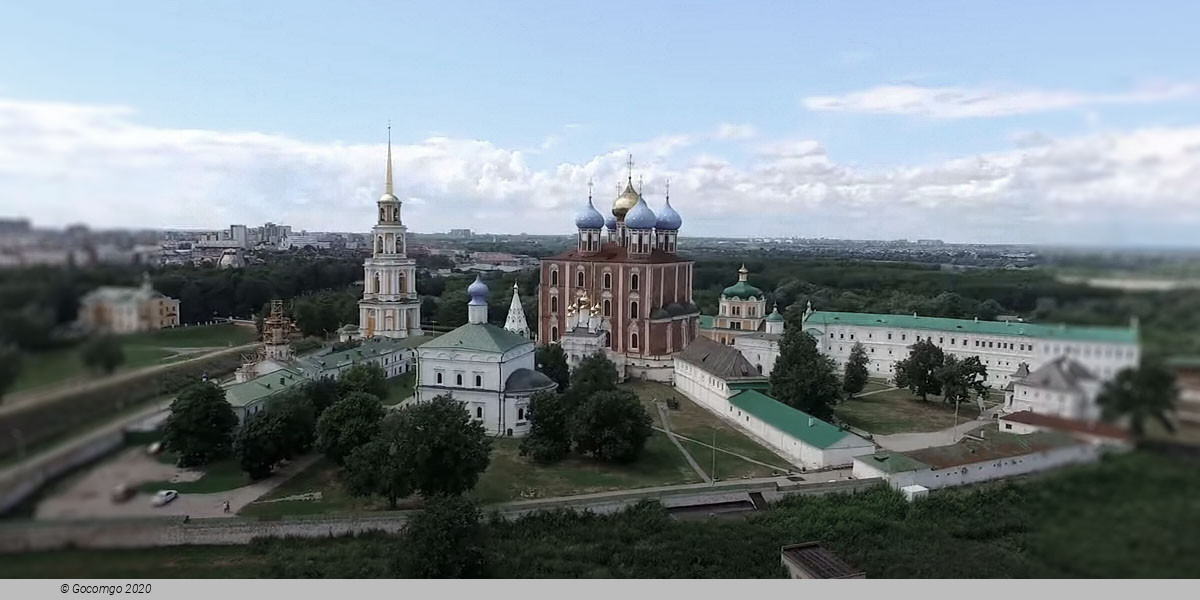Ryazan

Ryazan is the largest city and administrative center of Ryazan Oblast, Russia. The city is located on the right bank of the Oka River in Central Russia, 196 kilometers southeast of Moscow. Ryazan is among the most ancient cities in Russia. An older city, now named Staraya Ryazan, was located near modern-day Ryazan during the late middle ages and served as the capital of the Principality of Ryazan. During the Mongol invasion of Rus, the one was one of the first in Russia to be besieged and completely razed.
History
The area of Ryazan was settled by Slavic tribes around 6th century.
It is argued that the Ryazan kremlin was founded in 800, by Slavic settlers, as a part of their drive into territory previously populated by Volga Finnic peoples. Initially, it was built of wood, gradually replaced by masonry. The oldest preserved part of the Kremlin dates back to the 12th century.
However, the first written mention of the city, under the name of Pereslavl, dates to 1095. At that time, the city was part of the independent Principality of Ryazan, which had existed since 1078 and which was centered on the old city of Ryazan. The first ruler of Ryazan was supposedly Yaroslav Sviatoslavich, Prince of Ryazan and Murom (cities of Kievan Rus').
The lands of Ryazan, situated on the border of forest and steppe, suffered numerous invasions from the south as well as from the north, carried out by a variety of military forces including Cumans, but particularly the Principality was in a conflict with Vladimir-Suzdal. By the end of the 12th century, the capital of Duchy was burnt several times by the armies of Suzdal. Ryazan was the first Russian city to be sacked by the Mongol horde of Batu Khan. On December 21, 1237, it was thoroughly devastated and never fully recovered. As result of the sack, the seat of the principality was moved about 55 kilometers (34 mi) to the town of Pereslavl-Ryazansky, which subsequently took the name of the destroyed capital. The site of the old capital now carries the name of Staraya Ryazan (Old Ryazan), close to Spassk-Ryazansky.
In 1380, during the Battle of Kulikovo, the Grand Prince of Ryazan Oleg and his men came under a coalition of Mamai, a strongman of the Tatar Golden Horde, and the Grand Duke of Lithuania, against the armies under the command of the Grand Prince of Vladimir, Dmitry Donskoy.
Late in the 13th century, the Princes of Ryazan moved their capital to Pereslavl, which is known as Ryazan from the 16th century (officially renamed in 1778). The principality was finally incorporated into that of Moscow in 1521.
Soviet period
Ryazan was bombed by Germany in World War II.
Immediately after the war, the rapid development of the city began. Ryazan became a major industrial, scientific, and military center of the European part of Russia. Massive factories were constructed in the city, occupying the entire urban area. Such establishments included the largest refinery in Europe, the Soviet Union's only producer of potato-harvesting equipment - Ryazselmash Plant, accounting machines, a machine-tool plant, heavy forging equipment, foundry Centrolit, chemical fiber company, instrument factory, and others. Leading areas of the industry are heavy and non-ferrous metallurgy, oil refining and machine-tool industry, mechanical engineering, and food industries. More than half of the plants produce for export.
The military potential of the city has also developed: Ryazan became the main training center of the Airborne Forces of the Soviet Union - a city surrounded by numerous training centers and military training grounds. Several positioned MANPADS protect the urban sky. Besides the Airborne School, Ryazan hosts the Automobile School and Institute of Communications, a regiment of railway troops, airbase strategic bombers, and a training center in Diaghilev.
Ryazan developed particularly rapidly while Nadezhda Nikolaevna Chumakova served as Chair of the Council of People's Deputies of Ryazan and Ryazan mayor. Under Chumakova, the city's population increased more than seven times: from 72 to 520 thousand people. Chumakova oversaw the construction of social and cultural amenities, more than 20 urban areas, and hundreds of kilometers of the trolleybus, tram, and bus routes. Landscaping became a fundamental strategy for the development of the city at that time. A "green" ring of forests, parks, and garden associations surrounded Ryazan, with large parks located in each area of the city, and compositions of flowers and vertical gardening became customary, not only for the main streets but also for industrial zones and factory buildings. Ryazan repeatedly won recognition among the cities of the Soviet Union for its landscaping. During her 26 years in office, Nadezhda Chumakova often accepted awards of the Red Banner of the USSR on behalf of Ryazan.

